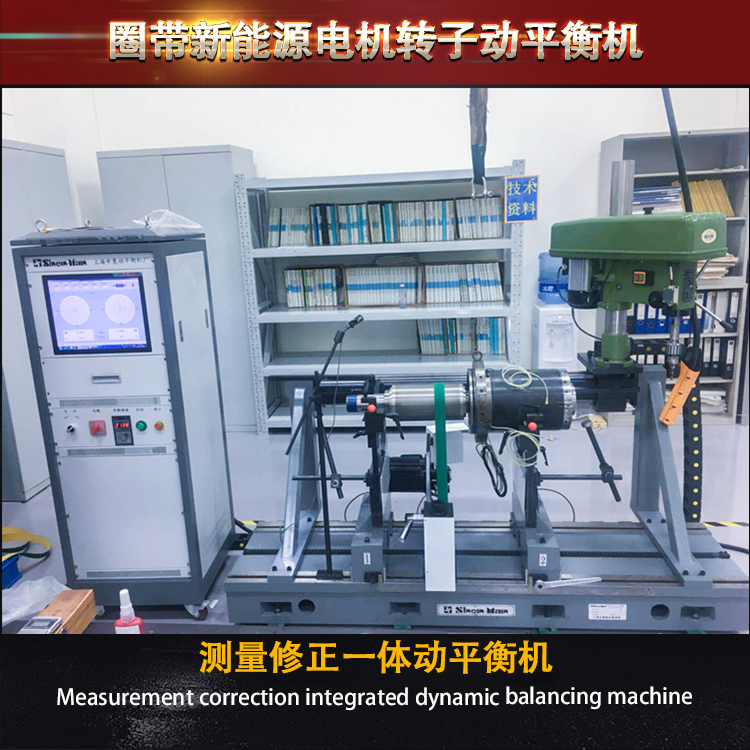The balancing machine detects and corrects the imbalance of the rotor, and ensures that the rotor can achieve the minimum imbalance within the rotor mass range under existing balancing machine technology conditions. The dynamic balance of the rotor is the adjustment of the unit mass range of the rotor itself, and its accuracy and balance state are irrelevant. Customers only need to install the rotor correctly to use the equipment with confidence.

Many customers often believe that the support method of a rotor balancing machine is consistent with its working state, but in fact, this is not the case. The dynamic balancing accuracy of the rotor on the equipment can meet all working requirements, which is precisely due to our lack of understanding of balancing machines. Due to our limited understanding of balancing machines, we often assume that the higher the balancing speed of dynamic balancing, the better the balancing accuracy. However, this is not the case in reality.
A hard supported balancing machine with good rigidity can accurately measure the imbalance at lower speeds, rather than the higher the speed, the better the balance accuracy. For rotors of different qualities and shapes, we will use different balancing speeds to achieve measurement efficiency and accuracy of the balancing machine. Generally speaking, the speed control of a hard supported balancing machine is within the range of 200-1500r/min, which can meet the requirements of most rotor dynamic balancing machines. For soft support balancing machines, there is a certain relationship between balancing speed and balancing accuracy. Within the speed range, the balance speed and balance accuracy are linear.
After collecting and organizing customer ideas and opinions, some customers believe that the balancing speed of the balancing machine should reach the working speed of the rotor, and the dynamic balancing accuracy of the rotor will reach the standard. This is because the customer's understanding of the concept of balanced speed is still unclear.
Balance speed: The speed of the balancing machine during the dynamic balance check. For rigid rotors, choose a lower speed as much as possible while ensuring accuracy. That is to say, the balancing machine can efficiently measure the rotor at a calibrated balancing speed.
Unstable data: The magnitude of the equilibrium speed is mainly related to the mass and shape of the rotor. Generally speaking, the larger the rotor mass, the lower the balance speed, but it is independent of the working speed.
When choosing a balancing machine, the quality of the balancing machine rotor and the quality of the balancing machine support are key reference indicators. Huake Zhichuang Dynamic Balance Machine Different models of dynamic balance machines can measure various types of rotors, so there are many types of balance machines produced, and all types of rotors can also be balanced. The quality of the rotor should be maintained within the allowable range of the load-bearing capacity of the balancing machine, in order to improve the efficiency of the balancing machine, maintain the accuracy of the balancing machine, and extend the service life of the dynamic balancing machine.

Many customers often believe that the support method of a rotor balancing machine is consistent with its working state, but in fact, this is not the case. The dynamic balancing accuracy of the rotor on the equipment can meet all working requirements, which is precisely due to our lack of understanding of balancing machines. Due to our limited understanding of balancing machines, we often assume that the higher the balancing speed of dynamic balancing, the better the balancing accuracy. However, this is not the case in reality.
A hard supported balancing machine with good rigidity can accurately measure the imbalance at lower speeds, rather than the higher the speed, the better the balance accuracy. For rotors of different qualities and shapes, we will use different balancing speeds to achieve measurement efficiency and accuracy of the balancing machine. Generally speaking, the speed control of a hard supported balancing machine is within the range of 200-1500r/min, which can meet the requirements of most rotor dynamic balancing machines. For soft support balancing machines, there is a certain relationship between balancing speed and balancing accuracy. Within the speed range, the balance speed and balance accuracy are linear.
After collecting and organizing customer ideas and opinions, some customers believe that the balancing speed of the balancing machine should reach the working speed of the rotor, and the dynamic balancing accuracy of the rotor will reach the standard. This is because the customer's understanding of the concept of balanced speed is still unclear.
Balance speed: The speed of the balancing machine during the dynamic balance check. For rigid rotors, choose a lower speed as much as possible while ensuring accuracy. That is to say, the balancing machine can efficiently measure the rotor at a calibrated balancing speed.
Unstable data: The magnitude of the equilibrium speed is mainly related to the mass and shape of the rotor. Generally speaking, the larger the rotor mass, the lower the balance speed, but it is independent of the working speed.
When choosing a balancing machine, the quality of the balancing machine rotor and the quality of the balancing machine support are key reference indicators. Huake Zhichuang Dynamic Balance Machine Different models of dynamic balance machines can measure various types of rotors, so there are many types of balance machines produced, and all types of rotors can also be balanced. The quality of the rotor should be maintained within the allowable range of the load-bearing capacity of the balancing machine, in order to improve the efficiency of the balancing machine, maintain the accuracy of the balancing machine, and extend the service life of the dynamic balancing machine.
157 browse
